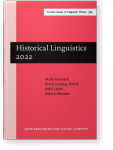Diachronic shifts among sound ideophones
We assess the depictive and descriptive character of sound ideophones and their historical evolution in
Emai of West Africa. Their initial depictive nature remains evident in phonological similarity to extant verbs with related
meanings and retention of a perfective aspect mark. In their descriptive mode ideophones appear as synchronic adverbs that
impact tonal marking within a clause. To account for their evolution from expressive acategorial forms to verbs, then to
adverbs we rely on two constructions of cause-effect, one being resultative and the other aspectual extent. Via analogy each
interacts with clausal expression of ideophonic forms leading to their recategorization and morphosyntactic integration into
the contemporary grammatical system, particularly as it applies to information flow in traditional narrative discourse.
Article outline
- 1.Introduction
- 2.Lexical character of ideophonic forms
- 3.Morphosyntactic character of ideophones
- 4.Cause-effect and analogy in ideophone development
- 5.Emai ideophones as adverb subclass
- 6.Conclusion
- Author queries
-
Acknowledgements
-
Abbreviations
-
References
This content is being prepared for publication; it may be subject to changes.
